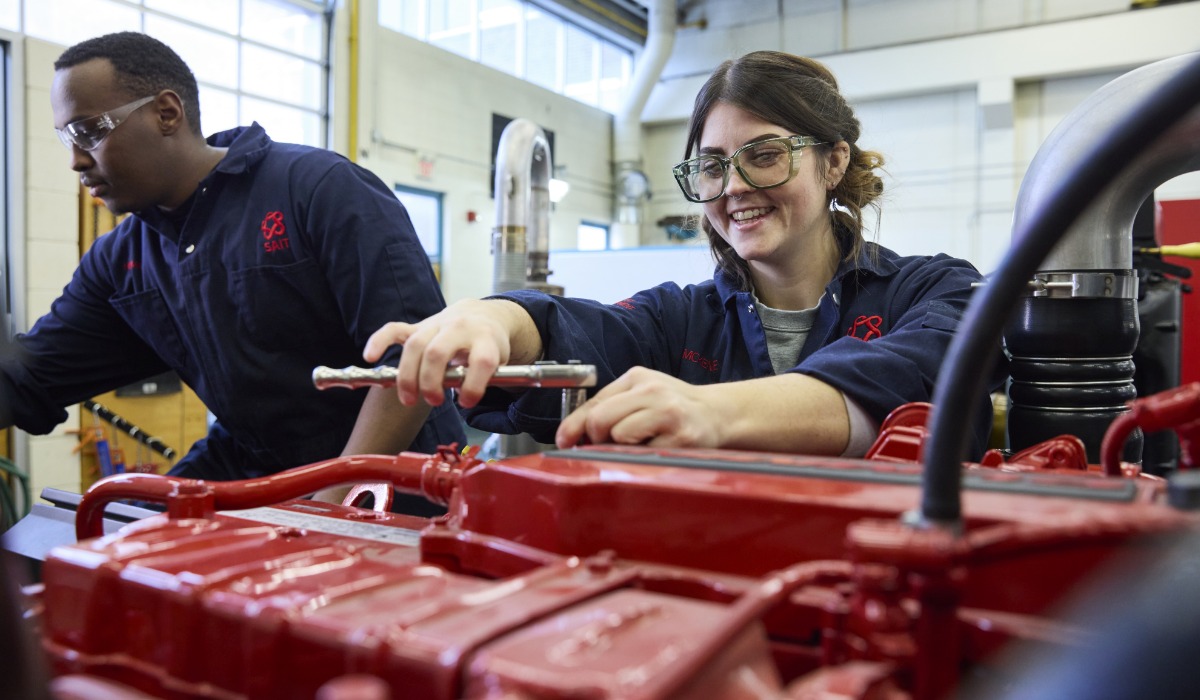Overview
Learn how to maintain, repair and overhaul heavy vehicles, transport trailers, heavy-duty off-road vehicles and industrial equipment.
If you enjoy mechanics, precise work and problem-solving, you'll enjoy working as a heavy equipment technician. You'll interpret orders, and diagnose faults and malfunctions before adjusting equipment or repairing and replacing defective parts or systems.
In Alberta, you may specialize as transport-trailer mechanics, truck and transport mechanics, heavy-duty equipment mechanics (off-road) or an overall heavy equipment technician.
To work in this trade, certification is required. This means that you must either be a registered apprentice who is working under the guidance of a certified journeyperson or you must be a certified journeyperson yourself.
Heavy equipment technicians are skilled tradespeople who are motivated and comfortable working alone or collaborating with others. This line of work is most fulfilling for those who enjoy working with their hands and are mechanically inclined.
To succeed in this trade, you should:
- have good vision, hearing and sense of smell to diagnose problems
- have the strength and stamina for working with heavy equipment
- be willing to work in cramped or awkward positions
- be comfortable working alone or with a team
- have mechanical ability and an interest in all types of machinery, engines, electronics and precision equipment
- have problem-solving skills and can think logically
- enjoy keeping up to date with changes in technology
- have a valid driver's license to operate equipment for testing purposes
- be committed to safe work practices.
Upon successfully completing the required working hours and technical training periods, you'll be awarded an educational credential in addition to journeyperson status by Alberta's Apprenticeship and Industry Training.
Educational credential earned per specialization:
- Heavy Equipment Technician: Advanced Diploma
- Heavy Duty Equipment Mechanic (Off-Road): Diploma
- Transport Trailer Mechanic: Certificate of Achievement
- Truck and Transport Mechanic (On-Road): Diploma
Heavy equipment technicians and their select specialties are Red Seal Endorsed trades – a recognizable standard that allows tradespeople to work across Canada.
- Transport trailer mechanic: transport trailer technicians maintain, repair and overhaul commercial transport devices that are connected to or moved by a power unit. You’ll provide maintenance and repair flat decks, dry freight vans, refrigerated vans, tankers, converters, boosters, pole trailers, jeeps, steering dollies, dump trailers and other commercial pull-type devices.
- Truck and transport mechanic (on-road): truck and transport mechanics maintain, repair and overhaul on-highway vehicles. You’ll work on internal combustion engines and components, on-highway vehicles, including buses and trucks, and towed on-highway and off-highway vehicles, including semi-trailers.
- Heavy-duty equipment technician (off-road): heavy-duty equipment technicians (off-road) maintain, repair and overhaul heavy equipment vehicles and industrial equipment. You’ll repair internal combustion engines and components, crawler tractors, ground-engaging equipment, earth-moving equipment, off-highway motor vehicles and towed off-highway vehicles.
- Heavy equipment technician (overall): heavy equipment technicians are trained to work on transport trailers, trucks and transport vehicles and off-road vehicles. You’ll maintain, repair and overhaul heavy vehicles and industrial equipment in a variety of settings.
Careers and opportunities
Our graduates may work in the following occupations. Some careers require additional experience and education.
Associated National Occupational Classification (NOC) codes: 22312, 72020, 72021,72401, 72410,72422, 72423 and 74203.
Apprenticeship training
Depending on the specialization, you'll spend two to four periods of apprenticeship education and on-the-job training before becoming a journeyperson.
The term of apprenticeship for a Heavy Equipment Technician is four years (four 12-month periods) including a minimum of 1500 hours of on-the-job training and eight weeks of classroom instruction each year.
Year 1 | Period 1
You'll learn about workplace safety, materials and tools. You'll also cover suspension, wheels, systems, hydraulics level one, hydraulic brake systems, electrical level one, electronics level one and airbrakes.
Training length: 8 weeks
Year 2 | Period 2
You’ll learn engine fundamentals, service, repair, engine systems, diesel fuel injection systems, electronic fuel management, heavy-duty charging and cranking systems.
Training length: 8 weeks
Year 3 | Period 3
You'll learn hydraulics level two, steering and suspension systems (specific to off-road), accessories (specific to off-road) and powertrain (specific to off-road).
Training length: 8 weeks
Year 4 | Period 4
You'll learn about powertrain (specific to truck and transport), steering, antilock brake systems, air conditioning, vehicle electrical diagnosis, failure and analysis.
Training length: 8 weeks
The term of apprenticeship for a heavy-duty equipment mechanic (Off-road) is three years (three 12-month periods) including a minimum of 1500 hours of on-the-job training and eight weeks of classroom instruction each year.
Year 1 | Period 1
You'll learn about workplace safety, materials and tools. You'll also cover suspension, wheels, systems, hydraulics level one, hydraulic brake systems, electrical level one, electronics level one and airbrakes.
Training length: 8 weeks
Year 2 | Period 2
You'll learn engine fundamentals, service, repair, engine systems, diesel fuel injection systems, electronic fuel management, heavy duty charging and cranking systems.
Training length: 8 weeks
Year 3 | Period 3
You'll learn hydraulics level two, steering and suspension systems (specific to off-road), accessories (specific to off-road) and powertrain (specific to off-road).
Training length: 8 weeks
The term of apprenticeship for a heavy equipment technician-transport trailer technician is two years (two 12-month periods) including a minimum of 1500 hours of on-the-job training and eight weeks of classroom instruction in the first period and a minimum of 1800 hours of on-the-job training in the second period.
Year 1 | Period 1
You'll learn about workplace safety, materials and tools. You’ll learn about suspension, wheels, systems, hydraulics level one, hydraulic brake systems, electrical level one, electronics level one and airbrakes.
Training length: 8 weeks
The term of apprenticeship for a truck and transport mechanic is three years (three 12-month periods) including a minimum of 1500 hours of on-the-job training and eight weeks of classroom instruction each year.
Year 1 | Period 1
You'll learn about workplace safety, materials and tools. You'll also cover suspension, wheels, systems, hydraulics level one, hydraulic brake systems, electrical level one, electronics level one and airbrakes.
Training length: 8 weeks
Year 2 | Period 2
You’ll learn engine fundamentals, service, repair, engine systems, diesel fuel injection systems, electronic fuel management, heavy-duty charging and cranking systems.
Training length: 8 weeks
Year 3 | Period 3
You'll learn about powertrain (specific to truck and transport), steering, antilock brake systems, air conditioning, vehicle electrical diagnosis, failure and analysis.
Training length: 8 weeks
Apprenticeship education performance
You must pass each section of the course and the AIT exam to succeed in apprenticeship education.
The passing grade for each period is no less than 50% in each course, with no less than a 65% average overall. A passing mark on each provincial exam and the interprovincial qualification (Red Seal Exam) is 70%.
View Alberta's Apprenticeship and Industry Training procedures
Training pathways
You can earn your journeyperson designation in the following way.
The traditional training pathway begins with finding a job with an employer willing to indenture you as an apprentice. Once you are an apprentice, you'll alternate between on-the-job training and educational periods.
You must apply for an apprenticeship through Alberta Apprenticeship and Industry Training before attending your first education period at SAIT.
SAIT’s two-year Transport and Heavy Equipment Technology diploma program equips you with the necessary skills and knowledge to successfully challenge the Alberta Apprenticeship and Industry Training (AIT) exams for Heavy Equipment Technician periods 1 through 4 as well as the Journeyman apprenticeship exam.
Pre-employment pathway
SAIT’s Pre-employment Heavy Equipment Technician program prepares you to enter into an apprenticeship with hands-on skills. Upon successfully completing the program, you’ll qualify to challenge the first-year Heavy Equipment Technician apprenticeship exam.
Admission requirements
To enter an apprenticeship, you must have the educational qualifications required or recommended education for the trade to which you apply.
Entrance requirements are monitored and set by Alberta Apprenticeship and Industry Training.
Minimum requirements
Successful completion of the following courses:
- English 20-2
- Math 20-3
- Science 10
OR
A pass mark in all five Canadian General Educational Development (GED) tests
OR
Alberta Apprenticeship and Industry Training entrance exam.
Recommended requirements
Apprentices with an Alberta High School Diploma that includes the following courses:
- English 30-2
- Math 30-3
- Physics 20 OR Chemistry 20 OR Science 20
- Related career and technology studies (CTS) courses
MyTradeSecrets
Once you have begun working as an apprentice, you can attend SAIT to complete your technical training.
You'll register for technical training at SAIT on MyTradeSecrets or you can register by phone.
Transfer agreements
At SAIT, we have created transfer agreements with partner institutions to allow you to earn course credits toward your SAIT program based on your previously completed credentials.
Transfer Alberta search tool
Use the Transfer Alberta search tool to see all transfer agreements between Alberta post-secondary institutions (including those with the University of Calgary, Mount Royal University and Bow Valley College.)
Search transfer agreements in Alberta
Transfer options for graduates
When you have completed this program, you may continue your education at a partner post-secondary institution. These transfer agreements include partnerships within and/or outside of Canada.
Credits this program transfers to
- Available credits:
- 57
- Available credits:
- 60
Available intakes
Costs
2025/26 tuition and fees
The following costs are effective as of July 1, 2025.
Heavy Equipment Technician (Alberta Only)
Heavy Equipment Technician - Heavy Duty Equipment Mechanic (Off-Road)
Heavy Equipment Technician - Transport Trailer Mechanic
| Period | Number of weeks | Tuition fees | Additional fees |
Total |
|---|---|---|---|---|
| 1 | 8 | $1,200 | $339.16 | $1,539.16 |
|
Total cost:
|
$1,539.16 | |||
Heavy Equipment Technician - Truck and Transport Mechanic (On-Road)
This is a bring-your-own-device program with standard computer hardware and software requirements. See the specific requirements on our computers and laptops page.
Books or modules, along with other items for classes, are approximately $600 per period.
We recommend you don't purchase books or modules ahead of time as they might be outdated by the time you attend classes, and they cannot be returned to the Bookstore.
Personal protective equipment (PPE) will be required for the program, which may be an additional cost to apprentices.
Funding options for apprentices
Apprentices get to learn while they earn, but there are still costs to consider. Many resources are available at SAIT and federally to help support apprentices.
Information sessions
Prepare for a strong start in your chosen program or get the details you need to decide your future path.
Our expert staff and faculty are ready to answer your questions and provide information about the following:
- What sets SAIT apart
- An introduction to the program and area of study
- Admission requirements
- Future career paths
- Information on the earning potential and graduate employment rates.
Contact
Have more questions?
Apprenticeship training and registration
Apprenticeship and Industry Training Client Services

Oki, Âba wathtech, Danit'ada, Tawnshi, Hello.
SAIT is located on the traditional territories of the Niitsitapi (Blackfoot) and the people of Treaty 7 which includes the Siksika, the Piikani, the Kainai, the Tsuut’ina and the Îyârhe Nakoda of Bearspaw, Chiniki and Goodstoney.
We are situated in an area the Blackfoot tribes traditionally called Moh’kinsstis, where the Bow River meets the Elbow River. We now call it the city of Calgary, which is also home to the Métis Nation of Alberta.
